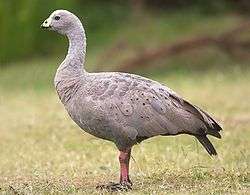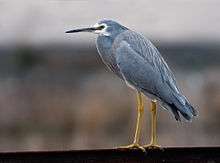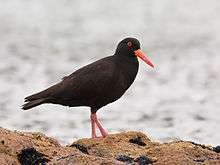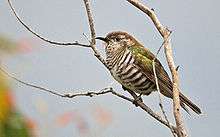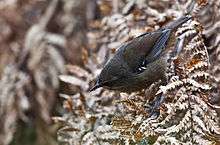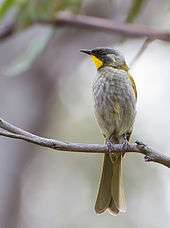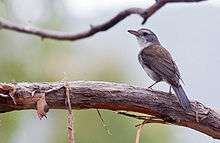List of birds of Tasmania

A total of 262 species of bird have been recorded living in the wild on the island of Tasmania, nearby islands and islands in Bass Strait, 182 of which are regularly recorded, while another 79 are vagrants and one is extinct. Birds of Macquarie Island are not included in this list. Twelve species are unique (endemic) to the island of Tasmania, and most of these are common and widespread.[1] However, the forty-spotted pardalote is rare and restricted, while the island's two breeding endemic species, the world's only migratory parrots, are both threatened.[2] Several species of penguin are late summer visitors to Tasmanian shores.[1] Tasmania's endemic birds have led to it being classified as an Endemic Bird Area (EBA), one of 218 such areas worldwide.[3] Priority regions for habitat-based conservation of birds around the world, they are defined by containing two or more restricted-range (endemic) species.[4]
Although Tasmania has been isolated from the Australian mainland for about 10,000 years, islands in the Bass Strait between the two landmasses have allowed many species to traverse. With around 5,400 km (3,400 mi) of coastline and 350 offshore islands, Tasmania provides a diverse haven for birds despite its relatively small size. Birds are abundant in Tasmanian wetlands and waterways, and ten of these habitats are internationally important and protected under the Ramsar Convention. Many migratory birds make use of the bays, mudflats and beaches for feeding, including the threatened hooded plover and little tern, both of which breed along the coast. The near-coastal button grass grasslands of the southwest, harbour the breeding grounds of the critically endangered orange-bellied parrot. Many of the rarer species dwell in Tasmania's eucalyptus (sclerophyll) forests or rainforests, which cover much of the island.[5]
The common and scientific names and taxonomic arrangement follow the conventions laid out in the 2008 publication Systematics and Taxonomy of Australian Birds.[6] Unless otherwise noted, all species listed below are considered to occur, or have occurred since European settlement in the case of extinct species, regularly in Tasmania as permanent residents, summer or winter visitors, or migrants. The following codes denote certain categories of species:
- (I) – Introduced: Birds that have been introduced to Tasmania by humans
- (Ex) – Extinct
- (V) – Uncommon vagrants to Tasmania
- (E) – Endemic to Tasmania
Emus
Order: Casuariformes Family: Dromaiidae
The Dromaiidae were represented in Tasmanian territory by two species, both now locally extinct. The King Island emu became extinct around 1802,[7] and the original populations of emus on Tasmania had vanished by 1865.[8] Whether or not the Tasmanian emu was a separate subspecies is unclear. The extant emus of Tasmania have originated from introduced emus from mainland Australia.
- Emu, Dromaius novaehollandiae (I)
- King Island emu, Dromaius ater (Ex)
New World quail
Order: Galliformes Family: Odontophoridae
The New World quails are small, plump terrestrial birds only distantly related to the quails of the Old World, but named for their similar appearance and habits. One species has become naturalised in Tasmania.
- California quail, Callipepla californica (I)
Pheasants
Order: Galliformes Family: Phasianidae
Phasianidae consists of the pheasants and their allies. These are terrestrial species, variable in size but generally plump, with broad, relatively short wings. Many species are gamebirds or have been domesticated as a food source for humans. Two species are native to Tasmania, and three commonly domesticated species are feral in King Island.
- Stubble quail, Coturnix pectoralis
- Brown quail, Coturnix ypsilophora
- Indian peafowl, Pavo cristatus (I)[fn 1]
- Common pheasant, Phasianus colchicus (I)[fn 1]
- Domestic turkey, Meleagris gallopavo (I)[fn 1]
Magpie goose
Order: Anseriformes Family: Anseranatidae
The family contains a single species, the Magpie goose. It was an early and distinctive offshoot of the anseriform family tree, diverging after screamers and before all other ducks, geese and swans, sometime in the late Cretaceous. The single species is a vagrant to Tasmania.
- Magpie goose, Anseranus semipalmata (V)
Ducks, geese and swans
Order: Anseriformes Family: Anatidae
The family Anatidae includes the ducks and most duck-like waterfowl, such as geese and swans. These are adapted for an aquatic existence, with webbed feet, bills that are flattened to a greater or lesser extent, and feathers that are excellent at shedding water due to special oils. In Tasmania, 15 species have been recorded, of which one has been introduced and three are vagrants.
- Plumed whistling duck, Dendrocygna eytoni (V)
- Musk duck, Biziura lobata
- Freckled duck, Stictonetta naevosa (V)
- Cape Barren goose, Cereopsis novaehollandiae
- Black swan, Cygnus atratus
- Australian shelduck, Tadorna tadornoides
- Australian wood duck, Chenonetta jubata
- Pink-eared duck, Malacorhynchus membranaceus (V)
- Australasian shoveler, Anas rhynchotis
- Grey teal, Anas gracilis
- Chestnut teal, Anas castanea
- Mallard, Anas platyrhynchos (I)
- Pacific black duck, Anas superciliosa
- Hardhead, Aythya australis
- Blue-billed duck, Oxyura australis
Grebes
Order: Podicipediformes Family: Podicipedidae
Grebes are small to medium-large freshwater diving birds. They have lobed toes and are excellent swimmers and divers. However, they have their feet placed far back on the body, making them quite ungainly on land. Three species have been recorded in Tasmania.
- Australasian grebe, Tachybaptus novaehollandiae
- Hoary-headed grebe, Poliocephalus poliocephalus
- Great crested grebe, Podiceps cristatus
Pigeons and doves
Order: Columbiformes Family: Columbidae
Pigeons and doves are stout-bodied birds with short necks and short slender bills with a fleshy cere. Seven species have been recorded in Tasmania, two of which have been introduced and another three are vagrants.
- Spotted dove, Spilopelia chinensis (I)
- Rock dove, Columba livia (I)
- Common bronzewing, Phaps chalcoptera
- Brush bronzewing, Phaps elegans
- Rose-crowned fruit dove, Ptilinopus regina (V)
- Superb fruit dove, Ptilinopus superbus (V)
- Topknot pigeon, Lopholaimus antarcticus (V)
Frogmouths
Order: Podargiformes Family: Podargidae
The frogmouths are a distinctive group of small nocturnal birds related to swifts found from India across southern Asia to Australia. One species is found in Tasmania.
- Tawny frogmouth, Podargus strigoides
Owlet-nightjars
Order: Aegotheliformes Family: Aegothelidae
The owlet-nightjars are a distinctive group of small nocturnal birds related to swifts found from the Maluku Islands and New Guinea to Australia and New Caledonia. There are eleven species, one of which is found in Tasmania.
- Australian owlet-nightjar, Aegotheles cristatus[fn 2]
Swifts
Order: Apodiformes Family: Apodidae
Swifts are small birds which spend the majority of their lives flying. These birds have very short legs and never settle voluntarily on the ground, perching instead only on vertical surfaces. Many swifts have long swept-back wings which resemble a crescent or boomerang. There are 98 species worldwide, with one reaching Tasmanuia.
- White-throated needletail, Hirundapus caudacutus
Storm petrels
Order: Procellariiformes Family: Oceanitidae
The storm petrels are the smallest seabirds, relatives of the petrels, feeding on planktonic crustaceans and small fish picked from the surface, typically while hovering. Their flight is fluttering and sometimes bat-like. One species has been regularly recorded in Tasmania's waters and two more are vagrants.
- Wilson's storm petrel, Oceanites oceanicus (V)
- White-bellied storm petrel, Fregetta grallaria (V)
- White-faced storm petrel, Pelagodroma marina
Albatrosses
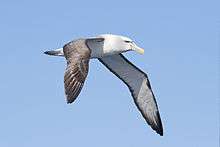
Order: Procellariiformes Family: Diomedeidae
The albatrosses are a family of 21 species of large seabird found across the Southern and North Pacific Oceans. The largest are among the largest flying birds in the world. Ten species are regularly seen in Tasmanian waters, with another three recorded less frequently and one vagrant species.[9]
- Wandering albatross, Diomedea exulans
- Antipodean albatross, Diomedea antipodensis
- Southern royal albatross, Diomedea epomophora
- Northern royal albatross, Diomedea sanfordi
- Black-browed albatross, Thalassarche melanophris
- Campbell albatross, Thalassarche impavida
- Shy albatross, Thalassarche cauta
- Salvin's albatross, Thalassarche salvini
- Chatham albatross, Thalassarche eremita (v)
- Grey-headed albatross, Thalassarche chrysostoma
- Yellow-nosed albatross, Thalassarche chlororhynchos
- Buller's albatross, Thalassarche bulleri
- Sooty albatross, Phoebetria fusca
- Light-mantled sooty albatross, Phoebetria palpebrata
Fulmars, petrels and shearwaters
Order: Procellariiformes Family: Procellariidae
The procellariids are the main group of medium-sized "true petrels", characterised by united nostrils with medium nasal septum and a long outer functional primary flight feather. Eleven species have been regularly recorded from Tasmanian waters, while another 20 species are vagrants.

- Southern giant petrel, Macronectes giganteus
- Northern giant petrel, Macronectes halli
- Southern fulmar, Fulmarus glacialoides (V)
- Antarctic petrel, Thalassoica antarctica (V)
- Cape petrel, Daption capense
- Broad-billed prion, Pachyptila vittata (V)
- Salvin's prion, Pachyptila salvini (V)
- Antarctic prion, Pachyptila desolata
- Slender-billed prion, Pachyptila belcheri (V)
- Fairy prion, Pachyptila turtur
- White-chinned petrel, Procellaria aequinoctialis (V)
- Westland petrel, Procellaria westlandica (V)
- Grey petrel, Procellaria cinerea (V)
- Sooty shearwater, Ardenna griseus
- Short-tailed shearwater, Ardenna tenuirostris
- Fluttering shearwater, Puffinus gavia
- Little shearwater, Puffinus assimilis (V)
- Buller's shearwater, Ardenna bulleri (V)
- Flesh-footed shearwater, Ardenna carneipes (V)
- Fluttering shearwater, Puffinus gavia (V)
- Hutton's shearwater, Puffinus huttoni (V)
- Wedge-tailed shearwater, Ardenna pacificus (V)
- Kerguelen petrel, Pterodroma brevirostris (V)
- Mottled petrel, Pterodroma inexpectata (V)
- Gould's petrel, Pterodroma leucoptera (V)
- Great-winged petrel, Pterodroma macroptera (V)
- Black-winged petrel, Pterodroma nigripennis (V)
- Providence petrel, Pterodroma solandri (V)
- White-headed petrel, Pterodroma lessonii
- Common diving petrel, Pelecanoides urinatrix
Penguins
Order: Sphenisciformes Family: Spheniscidae

Penguins are a group of aquatic, flightless birds living almost exclusively in the Southern Hemisphere, especially in Antarctica. One species breeds on the Tasmanian coast, while another ten have been recorded as vagrants.
- King penguin, Aptenodytes patagonicus (V)
- Gentoo penguin, Pygoscelis papua (V)
- Adelie penguin, Pygoscelis adeliae (V)
- Chinstrap penguin, Pygoscelis antarctica (V)
- Southern rockhopper penguin, Eudyptula chrysocome (V)
- Northern rockhopper penguin, Eudyptula moseleyi (V)
- Fiordland penguin, Eudyptes pachyrhynchus (V)
- Erect-crested penguin, Eudyptes sclateri (V)
- Snares penguin, Eudyptes robustus (V)
- Royal penguin, Eudyptes schlegeli (V)
- Little penguin, Eudyptula minor
Tropicbirds
Order: Phaethontiformes Family: Phaethontidae
Tropicbirds are slender white birds of tropical oceans, with exceptionally long central tail feathers. Their long wings have black markings, as does the head. One species is a vagrant to Tasmanian waters.
- Red-tailed tropicbird, Phaethon rubricauda (V)
Boobies and gannets

Order: Suliformes Family: Sulidae
The sulids comprise the gannets and boobies. Both groups are medium-large coastal seabirds that plunge-dive for fish. A single species has been recorded from Tasmania.
- Australasian gannet, Morus serrator
Darters
Order: Suliformes Family: Anhingidae
Darters are cormorant-like water birds with long necks and long, straight bills. They are fish eaters which often swim with only their neck above the water. One species is a vagrant to Tasmania.
- Australasian darter, Anhinga novaehollandiae (V)
Cormorants

Order: Suliformes Family: Phalacrocoracidae
Cormorants are medium-to-large aquatic birds, usually with mainly dark plumage and areas of coloured skin on the face. The bill is long, thin and sharply hooked. Their feet are four-toed and webbed, a distinguishing feature among the Pelecaniformes order. Four species occur in Tasmania, with a fifth as a vagrant.
- Little pied cormorant, Microcarbo melanoleucos
- Great cormorant, Phalacrocorax carbo
- Little black cormorant, Phalacrocorax sulcirostris
- Pied cormorant, Phalacrocorax varius (V)
- Black-faced cormorant, Phalacrocorax fuscescens
Pelicans
Order: Pelecaniformes Family: Pelecanidae
Pelicans are large water birds with distinctive pouches under their bills. Like other birds in the order Pelecaniformes, they have four webbed toes. One species has been recorded in Tasmania.
- Australian pelican, Pelecanus conspicillatus
Bitterns, herons and egrets
Order: Pelecaniformes Family: Ardeidae
The family Ardeidae contains the herons, egrets and bitterns. Herons and egrets are medium to large wading birds with long necks and legs. Bitterns tend to be shorter-necked and more secretive. Members of Ardeidae fly with their necks retracted, unlike other long-necked birds such as storks, ibises and spoonbills. Nine species have been recorded in Tasmania, one of which (the cattle egret) is a recent self-introduction and three others are vagrants.
- Australasian bittern, Botaurus poiciloptilus
- White-necked heron, Ardea pacifica (V)
- Eastern great egret, Ardea modesta
- Eastern cattle egret, Bubulcus coromandus
- White-faced heron, Egretta novaehollandiae
- Eastern reef egret, Egretta sacra (V)
- Intermediate egret, Egretta intermedia (V)
- Little egret, Egretta garzetta
- Nankeen night heron, Nycticorax caledonicus
Ibises and spoonbills
Order: Pelecaniformes Family: Threskiornithidae
The family Threskiornithidae includes the ibises and spoonbills. They have long, broad wings. Their bodies tend to be elongated, the neck more so, with rather long legs. The bill is also long, decurved in the case of the ibises, straight and distinctively flattened in the spoonbills. All five Australian mainland species have been recorded as vagrants in Tasmania.
- Glossy ibis, Plegadis falcinellus (V)
- Australian white ibis, Threskiornis moluccus (V)
- Straw-necked ibis, Threskiornis spinicollis (V)
- Royal spoonbill, Platalea regia (V)
- Yellow-billed spoonbill, Platalea flavipes (V)
Hawks, kites and eagles
Order: Accipitriformes Family: Accipitridae
Accipitridae is a family of birds of prey, which includes hawks, eagles, kites, harriers and Old World vultures. These birds have large powerful hooked beaks for tearing flesh from their prey, strong legs, powerful talons and keen eyesight. Twelve species have been recorded in Tasmania, while there are no confirmed records of a thirteenth species, the spotted harrier.
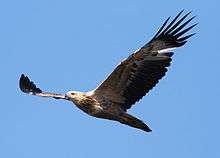
- Osprey, Pandion haliaetus (V)
- Black-shouldered kite, Elanus axillaris (V)
- Black-breasted buzzard, Hamirostra melanosternon (V)
- White-bellied sea eagle, Haliaeetus leucogaster
- Whistling kite, Haliastur sphenurus
- Black kite, Milvus migrans (V)
- Brown goshawk, Accipiter fasciatus
- Grey goshawk, Accipiter novaehollandiae
- Collared sparrowhawk, Accipiter cirrocephalus
- Swamp harrier, Circus approximans
- Wedge-tailed eagle, Aquila audax[fn 2]
- Little eagle, Hieraaetus morphnoides (V) [fn 3]
Caracaras and falcons
Order: Falconiformes Family: Falconidae
Falconidae is a family of diurnal birds of prey, notably the falcons and caracaras. They differ from hawks, eagles and kites in that they kill with their beaks instead of their talons. In Tasmania, four species have been recorded.
- Nankeen kestrel, Falco cenchroides
- Brown falcon, Falco berigora
- Australian hobby, Falco longipennis
- Peregrine falcon, Falco peregrinus
Rails, gallinules and coots
Order: Gruiformes Family: Rallidae
Rallidae is a large family of small- to medium-sized birds that includes the rails, crakes, coots and gallinules. The most typical family members occupy dense vegetation in damp environments near lakes, swamps or rivers. In general they are shy and secretive birds, making them difficult to observe. Most species have strong legs and long toes that are well adapted to soft uneven surfaces. They tend to have short, rounded wings and to be weak fliers. In Tasmania, eight species have been recorded, one endemic and another a vagrant.
- Australasian swamphen, Porphyrio melanotus
- Lewin's rail, Lewinia pectoralis
- Australian spotted crake, Porzana fluminea
- Spotless crake, Porzana tabuensis
- Dusky moorhen, Gallinula tenebrosa
- Tasmanian nativehen, Tribonyx mortierii (E)
- Black-tailed nativehen, Tribonyx ventralis (V)
- Eurasian coot, Fulica atra
Stone-curlews
Order: Charadriiformes Family: Burhinidae
The stone-curlews are a group of nine species of largely tropical and nocturnal birds. They are characterised by their strong black or yellow-black bills, large yellow eyes and cryptic plumage. One species is a vagrant to Tasmania.
- Bush stone-curlew, Burhinus grallarius (V)
Oystercatchers
Order: Charadriiformes Family: Haematopodidae
The oystercatchers are large and noisy plover-like birds, with strong bills used for smashing or prying open molluscs. Two species have been recorded from Tasmania.
- Pied oystercatcher, Haematopus longirostris
- Sooty oystercatcher, Haematopus fuliginosus
Stilts and avocets
Order: Charadriiformes Family: Recurvirostridae
Recurvirostridae is a family of large wading birds that includes the avocets and stilts. The avocets have long legs and long up-curved bills. The stilts have extremely long legs and long, thin, straight bills. All three mainland species have been recorded in Tasmania, although two are vagrants only.
- Black-winged stilt, Himantopus himantopus
- Banded stilt, Cladorhynchus leucocephalus (V)
- Red-necked avocet, Recurvirostra novaehollandiae (V)
Lapwings and plovers
Order: Charadriiformes Family: Charadriidae

The family Charadriidae includes the plovers, dotterels and lapwings. They are small- to medium-sized birds with compact bodies, short, thick necks and long, usually pointed, wings. They are often found in open country worldwide, mostly in habitats near water. In Tasmania, ten species have been recorded, three of which are vagrants.
- Pacific golden plover, Pluvialis fulva
- Red-capped plover, Charadrius ruficapillus
- Double-banded plover, Charadrius bicinctus
- Little ringed plover, Charadrius dubius (V)
- Greater sand plover, Charadrius leschenaultii (V)
- Oriental plover, Charadrius veredus (V)
- Black-fronted dotterel, Elseyornis melanops
- Hooded plover, Thinornis cucullatus
- Banded lapwing, Vanellus tricolor
- Masked lapwing, Vanellus miles (only the southern race v. m. novaehollandiae is found in Tasmania)
Painted-snipe
Order: Charadriiformes Family: Rostratulidae
The painted-snipes are a family of three snipe-like birds found in South America, Asia and Australia. The Australian species has recently been split from the Asian greater painted-snipe and is a vagrant to Tasmania.
- Australian painted-snipe, Rostratula australis (V)
Sandpipers, curlews, stints, godwits, snipes and phalaropes
Order: Charadriiformes Family: Scolopacidae

Scolopacidae is a large and diverse family of small- to medium-sized shorebirds, including the sandpipers, curlews, godwits, shanks, tattlers, woodcocks, snipes, dowitchers and phalaropes. The majority of these species eat small invertebrates picked out of the mud or soil. Different lengths of legs and bills enable multiple species to feed in the same habitat, particularly on the coast, without direct competition for food. Fourteen species have been recorded in Tasmania, five as vagrants only.
- Latham's snipe, Gallinago hardwickii
- Bar-tailed godwit, Limosa lapponica
- Whimbrel, Numenius phaeopus
- Far Eastern curlew, Numenius madagascariensis
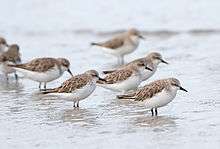
- Common greenshank, Tringa nebularia
- Grey-tailed tattler, Tringa brevipes
- Ruddy turnstone, Arenaria interpres
- Red-necked stint, Calidris ruficollis
- Red knot, Calidris canutus
- Curlew sandpiper, Calidris ferruginea
- Baird's sandpiper, Calidris bairdii (V)
- Western sandpiper, Calidris mauri (V)
- Ruff, Philomachus pugnax (V)
- Buff-breasted sandpiper, Tryngites subruficollis (V)
- Red-necked phalarope, Phalaropus lobatus (V)
Buttonquail
Order: Charadriiformes Family: Turnicidae
The buttonquail are an ancient lineage of shorebirds which closely resemble true quail in appearance but are unrelated. They are found in Africa, Asia and Australia, with one species reaching Tasmania.
- Painted buttonquail, Turnix varius
Skuas
Order: Charadriiformes Family: Stercorariidae
The skuas are in general medium to large birds, typically with grey or brown plumage, often with white markings on the wings. They have longish bills with hooked tips and webbed feet with sharp claws. They look like large dark gulls, but have a fleshy cere above the upper mandible. They are strong, acrobatic fliers. A single species is regularly found in Tasmanian waters, while two others are vagrants.
- Arctic skua, Stercorarius parasiticus
- Long-tailed skua, Stercorarius longicauda (V)
- South polar skua, Catharacta maccormicki (V)
Gulls and terns
Order: Charadriiformes Family: Laridae
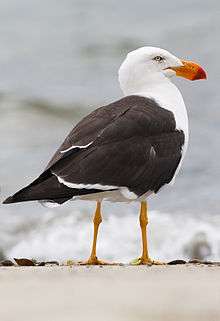
Gulls are typically medium to large birds, usually grey or white, often with black markings on the head or wings. They have stout, longish bills and webbed feet. The large species take up to four years to attain full adult plumage, but two years is typical for small gulls. In Tasmania, three species have been recorded. Terns are in general medium-to-large birds, typically with grey or white plumage, often with black markings on the head. They have longish bills and webbed feet. They are lighter-bodied and more streamlined than gulls and look elegant in flight with long tails and long narrow wings. In Tasmania, thirteen species of gulls and terns have been recorded, five of which are vagrants. The two groups have been considered separate families, but some findings that the noddies and white tern are offshoots to the combined group have led the two to be classified as a single family for the time being.
- Pacific gull, Larus pacificus
- Kelp gull, Larus dominicanus
- Silver gull, Chroicocephalus novaehollandiae
- Bridled tern, Onychoprion anaetheetus (V)
- Little tern, Sternula albifrons
- Fairy tern, Sternula nereis
- Gull-billed tern, Gelochelidon nilotica (V)
- Caspian tern, Hydroprogne caspia
- Whiskered tern, Chlidonias hybrida (V)
- Common tern, Sterna hirundo (V)
- Arctic tern, Sterna paradisaea (V)
- Greater crested tern, Thalasseus bergii
- White-fronted tern, Sterna striata
Cockatoos

Order: Psittaciformes Family: Cacatuidae
Cockatoos are a distinctive lineage of parrots notable for their crests and lack of colour in their plumage. Generally large and noisy, they are a familiar part of the Australian (and Tasmanian) landscape. Six species are found in Tasmania, two of which are considered to be aviary escapees and hence introduced and one a vagrant.
- Yellow-tailed black cockatoo, Calyptorhynchus funereus
- Gang-gang cockatoo, Callocephalon fimbriatum (V)
- Galah, Eolophus roseicapilla
- Long-billed corella, Cacatua tenuirostris (I)
- Little corella, Cacatua sanguinea (I)
- Sulphur-crested cockatoo, Cacatua galerita
True parrots
Order: Psittaciformes Family: Psittaculidae
- Rainbow lorikeet, Trichoglossus haemotodus (I)
- Little lorikeet, Glossopsitta pusilla (I)
- Musk lorikeet, Glossopsitta concinna
- Green rosella, Platycercus caledonicus (E)
- Eastern rosella, Platycercus eximius
- Swift parrot, Lathamus discolor[fn 4]
- Blue-winged parrot, Neophema chrysostoma
- Orange-bellied parrot, Neophema chrysogaster[fn 4]
- Eastern ground parrot, Pezoporus wallicus
Cuckoos
Order: Cuculiformes Family: Cuculidae
The family Cuculidae includes cuckoos, roadrunners and anis. These birds are of variable size with slender bodies, long tails and strong legs. There are 138 species worldwide and 4 species which occur in Tasmania, all of which are parasitic.
- Pallid cuckoo, Cacomantis pallidus
- Fan-tailed cuckoo, Cacomantis flabelliformis
- Horsfield's bronze cuckoo, Chrysococcyx basalis
- Shining bronze cuckoo, Chrysococcyx lucidus
Typical owls
Order: Strigiformes Family: Strigidae
The typical owls are small to large solitary nocturnal birds of prey. They have large forward-facing eyes and ears, a hawk-like beak and a conspicuous circle of feathers around each eye called a facial disk. One species has been recorded in Tasmania.
- Southern boobook, Ninox novaeseelandiae
Barn owls
Order: Strigiformes Family: Tytonidae
Barn owls are medium to large owls with large heads and characteristic heart-shaped faces. They have long strong legs with powerful talons. One species is found in Tasmania.
- Australian masked owl, Tyto novaehollandiae[fn 2]
Kingfishers
Order: Coraciiformes Family: Alcedinidae
Kingfishers are medium-sized birds with large heads, long pointed bills, short legs and stubby tails.
- Azure kingfisher, Ceyx azurea[fn 2]
- Laughing kookaburra, Dacelo novaeguineae (I)[fn 5]
- Sacred kingfisher, Todiramphus sanctus (V) [fn 6]
Lyrebirds
Order: Passeriformes Family: Menuridae
The lyrebirds are two species of ground-dwelling Australian birds, notable for their accomplished mimicry. One species has been introduced to Tasmania.
- Superb lyrebird, Menura novaehollandiae (I)[fn 5]
Fairywrens

Order: Passeriformes Family: Maluridae
The fairywrens are a family of small, insectivorous passerine birds endemic to Australia and New Guinea. Most closely related to honeyeaters and pardalotes, they are more closely related to crows than to true wrens of the Northern Hemisphere. Two species are native to Tasmania.
- Superb fairywren, Malurus cyaneus[fn 2]
- Southern emu-wren, Stipiturus malachurus
Pardalotes
Order: Passeriformes Family: Pardalotidae
The pardalotes are a small family of very small, brightly coloured birds native to Australia, with short tails, strong legs and stubby blunt beaks. They feed on insects, generally in the canopy of eucalypts and nest in burrows. Three species are found in Tasmania, of which one is endemic and endangered.
- Spotted pardalote, Pardalotus punctatus
- Forty-spotted pardalote, Pardalotus quadragintus (E)
- Striated pardalote, Pardalotus striatus
Thornbills and scrubwrens
Order: Passeriformes Family: Acanthizidae
The Acanthizidae are a group of 35 species of small to medium mostly insectivorous passerine birds found in Australia, Indonesia, New Zealand and the south-west Pacific. They have short rounded wings, slender bills, long legs and a short tail. Most species have olive, grey or brown plumage, although some have patches of a brighter yellow. Six species are found in Tasmania, of which three are endemic.
- Tasmanian scrubwren, Sericornis humilis (E)
- Scrubtit, Acanthornis magnus (E)
- Striated fieldwren, Calamanthus fuliginosus
- Brown thornbill, Acanthiza pusilla
- Tasmanian thornbill, Acanthiza ewingii (E)
- Yellow-rumped thornbill, Acanthiza chrysorrhoa
Honeyeaters
Order: Passeriformes Family: Meliphagidae
Honeyeaters are a diverse and widespread group of nectar and insect-eating birds found across Australia and surrounding regions. Eleven species are found in Tasmania, of which four are endemic, including Australia's largest honeyeater, the yellow wattlebird.
- Yellow wattlebird, Anthochaera paradoxa (E)
- Little wattlebird, Anthochaera chrysoptera
- Noisy miner, Manorina melanocephala
- Yellow-throated honeyeater, Nesoptilotis flavicollis (E)
- Strong-billed honeyeater, Melithreptus validirostris (E)
- Black-headed honeyeater, Melithreptus affinis (E)
- Crescent honeyeater, Phylidonyris pyrrhoptera
- New Holland honeyeater, Phylidonyris novaehollandiae
- Tawny-crowned honeyeater, Gliciphila melanops
- Eastern spinebill, Acanthorhynchus tenuirostris
- White-fronted chat, Epthianura albifrons
Quail-thrushes and allies
Order: Passeriformes Family: Psophodidae
The quail-thrushes are medium-sized songbirds found in open forest and scrub. Adapted for ground living, they have strong legs and beaks. They are sometimes classified in the family Cinclosomatidae along with jewel-babblers, or united with the family Psophodidae, containing the wedgebills and whipbirds. One species reaches Tasmania.
- Spotted quail-thrush, Cinclosoma punctatum
Cuckooshrikes
Order: Passeriformes Family: Campephagidae
The cuckooshrikes are a family of predominantly drab-coloured insectivorous birds from Australia and southeast Asia that are related to neither cuckoos nor shrikes. One species reaches Tasmania.
- Black-faced cuckooshrike, Coracina novaehollandiae
Whistlers and shrikethrushes
Order: Passeriformes Family: Pachycephalidae
The whistlers and shrikethrushes are a large group of stocky passerines found in Australia and surrounding regions. Primarily insectivorous, larger species may also eat small vertebrates such as frogs or nestling birds. Most have drab plumage, the golden whistler a notable exception, and several are accomplished songsters. Three species are found in Tasmania.
- Olive whistler, Pachycephala olivacea
- Golden whistler, Pachycephala pectoralis
- Grey shrikethrush, Colluricincla harmonica
Woodswallows, butcherbirds, Australian magpie and currawongs
Order: Passeriformes Family: Artamidae
Now known to be related to the Vangidae of Madagascar, the Artamidae are a collection of crow-like birds as well as the smaller woodswallows. They include some of the most familiar and most accomplished songbirds of the Australian (and Tasmanian) landscape. Six species are found in Tasmania. One is endemic and two more are endemic subspecies.
- White-breasted woodswallow, Artamus leucorynchus (V)[fn 7]
- Dusky woodswallow, Artamus cyanopterus
- Grey butcherbird, Cracticus torquatus[fn 2]
- Australian magpie, Gymnorhina tibicen [fn 2]
- Black currawong, Strepera fuliginosa (E)
- Grey currawong, Strepera versicolor[fn 2]
Fantails
Order: Passeriformes Family: Rhipiduridae
Fantails are a family of small insectivorous birds of southern Asia and Australasia related to monarchs and drongos (all three are sometimes combined in the one family). One species is resident while another is a vagrant.
- Grey fantail, Rhipidura fuliginosa
- Willie wagtail, Rhipidura leucophrys (V)[fn 8]
Crows, ravens, true magpies and jays
Order: Passeriformes Family: Corvidae
The family Corvidae includes crows, ravens, jays, choughs, magpies, treepies, nutcrackers and ground jays. Corvids are above average in size among the Passeriformes, and some of the larger species show high levels of intelligence. Two black-plumaged ravens are found in Tasmania.
- Forest raven, Corvus tasmanicus
- Little raven, Corvus mellori
Monarchs and magpie-lark
Order: Passeriformes Family: Monarchidae
The monarch flycatchers are a diverse family of around 140 species of passerine birds found from Africa to Australia. Closely related to the drongo family Dicruridae, they are sometimes classified as a subfamily within it. Monarchs generally live in the canopy or understory in forest habitats, although one species is ground-dwelling. One species is found in Tasmania.
- Satin flycatcher, Myiagra cyanoleuca
Australian robins
Order: Passeriformes Family: Petroicidae
Australian robins are a group of small insectivorous birds, whose exact position in the bird family tree is unclear. Named after a superficial resemblance to the European robin, the males of many species sport bright red or pink on their plumage. Four species are found in Tasmania, of which one is endemic.
- Scarlet robin, Petroica boodang
- Flame robin, Petroica phoenicea
- Pink robin, Petroica rodinogaster
- Dusky robin, Melanodryas vittata (E)
Larks
Order: Passeriformes Family: Alaudidae
Larks are small terrestrial birds with often extravagant songs and display flights. Most larks are fairly dull in appearance. They feed on insects and seeds. One species has been introduced to Tasmania.
- Skylark, Alauda arvensis (I)
Cisticolas
Order: Passeriformes Family: Cisticolidae
The cisticolas and allies are family of about 110 small passerine birds found mainly in warmer southern regions of the Old World. They are often included within the Old World warbler family Sylviidae. One species reaches Tasmania.
- Golden-headed cisticola, Cisticola exilis
Grassbirds and songlarks
Order: Passeriformes Family: Locustellidae
Locustellidae, commonly known as grassbirds, songlarks and megalurid warblers, is a newly recognized family of small insectivorous songbirds related to the Old World warblers. One species reaches Tasmania.
- Little grassbird, Megalurus gramineus
White-eyes
Order: Passeriformes Family: Zosteropidae
The white-eyes are a large family of mostly Old World passerine birds. They are rather diverse in size and colouration, but are characterised by soft fluffy plumage. These are birds of tropical areas, with the greatest variety in Southeast Asia. One species reaches Tasmania.
- Silvereye, Zosterops lateralis
Swallows and martins
Order: Passeriformes Family: Hirundinidae
The family Hirundinidae is adapted to aerial feeding. They have a slender streamlined body, long pointed wings and a short bill with a wide gape. The feet are adapted to perching rather than walking and the front toes are partially joined at the base. Two species have been recorded in Tasmania.
- Welcome swallow, Hirundo neoxena
- Tree martin, Hirundo nigricans
Thrushes
Order: Passeriformes Family: Turdidae
The true thrushes are a group of passerine birds that occur mainly but not exclusively in the Old World. Two species, one native and one introduced, occur in Tasmania.
- Bassian thrush, Zoothera lunulata
- Blackbird, Turdus merula (I)
Starlings
Order: Passeriformes Family: Sturnidae
Starlings are small- to medium-sized Old World passerine birds with strong feet. Their flight is strong and direct and most are gregarious. Their preferred habitat is fairly open country, and they eat insects and fruit. The plumage of several species is dark with a metallic sheen. One species has been introduced into Tasmania.
- European starling, Sturnus vulgaris (I)
Estrildid finches
Order: Passeriformes Family: Estrildidae
Estrildid finches are small finch- or sparrow-like birds of the Old World tropics and Australasia. One species reaches Tasmania.
- Beautiful firetail, Stagonopleura bella
Old World sparrows
Order: Passeriformes Family: Passeridae
Old World sparrows are small passerine birds. These sparrows tend to be small plump brownish or greyish birds with short tails and short powerful beaks. Sparrows are seed eaters, but they also consume small insects. One species has been introduced to Tasmania.
- House sparrow, Passer domesticus (I)
Wagtails and pipits
Order: Passeriformes Family: Motacillidae
Motacillidae is a family of small passerine birds with medium to long tails. They include the wagtails, longclaws and pipits. They are slender, ground-feeding insectivores of open country. One species have been recorded in Tasmania.
- Australasian pipit, Anthus novaeseelandiae
Finches
Order: Passeriformes Family: Fringillidae
Finches are seed-eating passerine birds that are small to moderately large and have a strong beak, usually conical and in some species very large. All have twelve tail feathers and nine primaries. These birds have a bouncing flight with alternating bouts of flapping and gliding on closed wings, and most sing well. Two species have been introduced to Tasmania.
- European greenfinch, Chloris chloris (I)
- European goldfinch, Carduelis carduelis (I)
See also
Species footnotes
- 1 2 3 HANZAB 2, p. 373.
- 1 2 3 4 5 6 7 8 Subspecies is endemic to Tasmania
- ↑ One record on Curtis Island in Bass Strait
- 1 2 One of only two species of migratory parrot, both of which breed only in Tasmania
- 1 2 Although native to eastern Australia, introduced to Tasmania
- ↑ Sharland (1981), p 122
- ↑ HANZAB 7, p. 402.
- ↑ HANZAB 7, p. 228.
References
- General
- "Birds of Tasmania: Tasmanian Bird List". Parks & Wildlife Service, Tasmania. Department of Primary Industries, Parks, Water and Environment, Government of Tasmania. 22 June 2009. Retrieved 26 May 2010. (for all birds on list unless otherwise indicated)
- Christidis, Les; Boles, Walter E. (2008). Systematics and Taxonomy of Australian Birds. Canberra: CSIRO Publishing. ISBN 978-0-643-06511-6. (for current classification of birds listed)
- Higgins, Peter Jeffrey; Peter, John M.; Cowling, Sid J. (eds.) (2006). Handbook of Australian, New Zealand and Antarctic Birds. Volume 7: Boatbill to Starlings. Melbourne: Oxford University Press. ISBN 978-0-19-553996-7.
- Marchant, Stephen; Higgins, Peter Jeffrey (eds.) (1990). Handbook of Australian, New Zealand and Antarctic Birds. Volume 1: Ratites to Ducks. Melbourne: Oxford University Press. ISBN 0-19-553244-9.
- Marchant, Stephen; Higgins, Peter Jeffrey (eds.) (1993). Handbook of Australian, New Zealand and Antarctic Birds. Volume 2: Raptors to Lapwings. Melbourne: Oxford University Press. ISBN 0-19-553069-1.
- Sharland, Michael (1981). A Guide To The Birds of Tasmania. Hobart: Drinkwater Publishing.
- Specific
- 1 2 "Tasmania". Birds Australia website. Birds Australia. Retrieved 27 May 2010.
- ↑ Dooley, Sean (11 May 2010). "World's only migratory parrots in peril". Australian Geographic. Retrieved 27 May 2010.
- ↑ "BirdLife EBA Factsheet 185: Tasmania". BirdLife's online World Bird Database: the site for bird conservation. Cambridge, UK: BirdLife International. 2003. Retrieved 27 May 2010.
- ↑ "Endemic Bird Areas". BirdLife's online World Bird Database: the site for bird conservation. Cambridge, UK: BirdLife International. 2003. Retrieved 27 May 2010.
- ↑ Watts, Dave (2006) [1999]. Field Guide to Tasmanian Birds (2nd ed.). Frenchs Forest, NSW: New Holland Press. pp. vi–viii. ISBN 1-876334-60-6.
- ↑ Christidis, Leslie; Boles, Walter (1994). The Taxonomy and Species of Birds of Australia and its Territories. Royal Australasian Ornithologists Union. ISBN 978-1-875122-06-6.
- ↑ Brasil, L. (1914). "The Emu of King Island". Emu. 14 (2): 88–97. doi:10.1071/MU914088.
- ↑ HANZAB 1, p. 49.
- ↑ "Eaglehawk Pelagic". Eremaea. Retrieved November 22, 2013.
